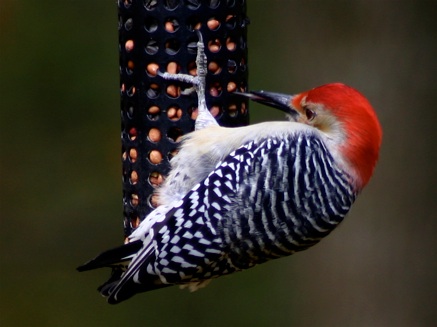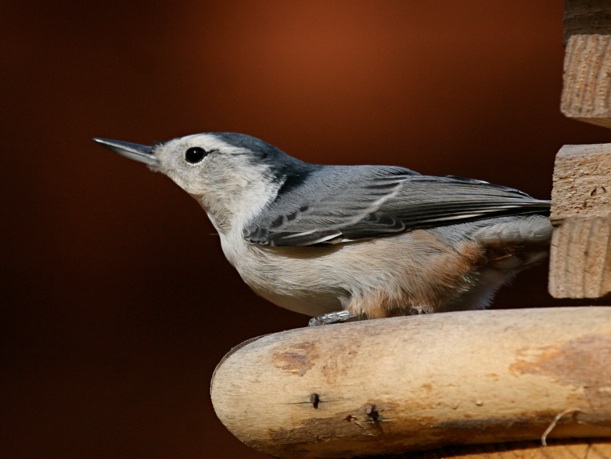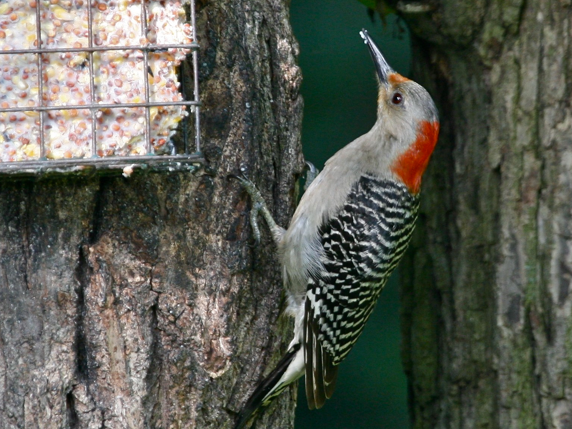The Nature
Observer’s Journal
The Nature
Observer’s Journal

Patience
by Chuck Tague
I knew something was up. The birds that hang around the feeder were gone. No Mourning Doves stood watch, the goldfinches abandoned their thistle tube and the titmice, chickadees and juncos had all disappeared.
The one remaining bird told the story.
The Red-bellied Woodpecker stuck to the trunk of the elm like a magnet to a refrigerator. Its back was to the house and the tree concealed the bird from the street and walkway. I watched for several minutes. This normally noisy and animated bird hung motionless, lifeless, frozen in place, as if it were playing hide and seek.
It was hiding, but this was no game.
A predator was nearby.
Earth-bound cats, dogs and other awkward mammals pose no threat to healthy, alert woodpeckers. The Red-belly’s patient wait told me the danger was a bird of prey.
The Red-bellied Woodpecker is about the size of a robin and a strong flyer. It doesn’t worry too much about the clumsy Red-tailed Hawk that hunts squirrels in the woods. Nor does it fear the small birds of prey that ambush the chickadees and sparrows.
Possibly the neighborhood Cooper’s Hawk was terrorizing the bird feeder. This crow-sized hunter has short wings and a long tail. It careens between the houses snagging starlings and doves before they have a chance to react. Could it be a Merlin? The day before I spotted one testing the neighborhood songbirds. This pigeon-sized falcon uses its speed to chase down anything that flies. I wondered if the Merlin had returned.
Whatever the predator, I must have just missed its attack. The woodpecker’s position indicated the predator appeared from either over the roof or from the side of the house. I couldn’t tell if the attacker had moved on or was watching from some concealed position. The birds were not taking any chances.
I observed the motionless woodpecker for several more minutes. No other North American bird has a less appropriate name. Its belly does have a faint red wash, but this would be impossible to see, even if I could see its underside. This insignificant shading pales in comparison with some of its other features. Its white back is crossed with ladder-like black bars. In flight, with each flap of its wings it flashes white then black. The male wears a red hood so surprisingly bright it reminds me of sudden brake lights I didn’t expect.


Red-bellied Woodpecker male
Just then the mailman turned the corner. Usually a flourish of wings precedes him. The birds give the mailman a wide berth, but they never go very far. The finches fly higher into the tree. The chickadees hide close by and the Mourning Doves move to the sycamore at the end of the walk. Even before the mailman finishes dropping the mail in the slot the birds begin to trickle back. Within seconds of his departure everything is back to normal.
No birds moved as the mailman walked toward the house. I was concerned that the Red-belly might abandon the safety of the elm. This skittish woodpecker is usually the first to fly when a human approaches.
The Red-belly held its position. The mailman passed within five feet of it. He never saw the brightly colored but motionless bird.
The mailman entered the yard across the walk and a less cautious Mourning Dove flushed from under the hedge. It landed in the elm. I watched nervously. No hawk or falcon attacked. The dove’s indiscretion was not a fatal mistake.
My phone rang. Reluctantly I turned away from the life and death drama in my yard. When I returned the finches and doves were back. The woodpecker was gone.
The finches and doves fed with restless anticipation.
Life at my feeder went on.

Thursday, January 14, 2010
